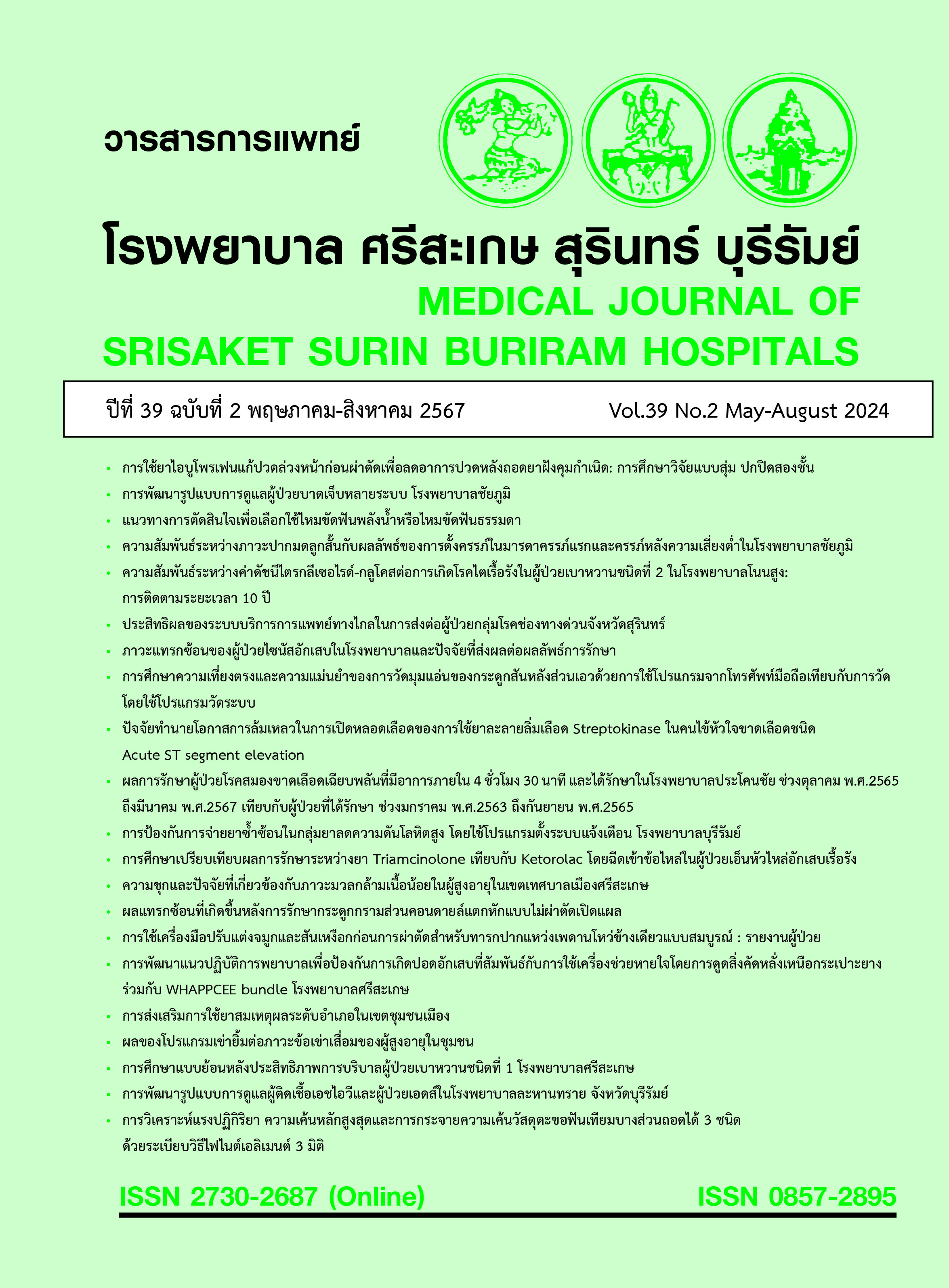การศึกษาความเที่ยงตรงและความแม่นยำของการวัดมุมแอ่นของกระดูกสันหลังส่วนเอวด้วยการใช้โปรแกรมจากโทรศัพท์มือถือเทียบกับการวัดโดยใช้โปรแกรมวัดระบบ Picture Archiving and Communication System (PACS)
Main Article Content
บทคัดย่อ
หลักการและเหตุผล: มุมแอ่นกระดูกสันหลังช่วงเอวเป็นพารามิเตอร์ที่สำคัญสำหรับการผ่าตัดกระดูกสันหลัง อย่างไรก็ตามศัลยแพทย์ส่วนใหญ่ใช้การประเมินโดยการประมาณจากการดูภาพถ่ายจากเครื่องฟลูออโรสโคปี้ระหว่างผ่าตัดซึ่งขาดความแม่นยำ ทางคณะผู้วิจัยจึงพัฒนาเทคนิคคอบบ์เตอร์ วิธีใหม่ซึ่งช่วยให้การวัดมุมง่ายขึ้นเพียงอาศัยแอปพลิเคชั่นที่ติดตั้งมาแล้วในสมาร์ทโฟน
วัตถุประสงค์: เพื่อเปรียบเทียบความแม่นยำและเที่ยงตรงของเทคนิคคอบบ์เตอร์เทียบกับมาตรฐานการวัดมุมภาพถ่ายรังสีโดยใช้เครื่องมือวัดมุมในระบบจัดเก็บรูปภาพทางการแพทย์ PACS (Picture Archiving and Communication System)
วิธีการศึกษา: เป็นการศึกษาย้อนหลังภาพถ่ายรังสีของผู้ป่วยซึ่งเข้ารับการผ่าตัดรักษาทึ่แผนกออโธปิดิกส์ โรงพยาบาลสุรินทร์ รังสีด้านข้างของกระดูกสันหลังส่วนเอวในท่ายืน ผู้วิจัย 2 คนวัดภาพถ่ายรังสีด้วยวิธีทั้ง 2 วิธีอย่างเป็นอิสระต่อกัน
ผลการศึกษา: ภาพถ่ายรังสีของผู้ป่วย 32 ราย ได้รับการวัดและวิเคราะห์ผล พบว่าวิธีคอบบ์เตอร์ไม่ได้มีความแตกต่างจากวิธีมาตรฐานผ่านระบบ PACS ในด้านความแม่นยำอย่างมีนัยสำคัญทางสถิติ (p=0.26) แม้ว่านำผู้ป่วยกลุ่มที่มุมแอ่นสูงมากกว่า 40 องศามาวิเคราะห์แยกส่วนแล้วก็ตาม (p=0.517) ผลการวิเคราะห์ความเที่ยงของวิธีคอบบ์เตอร์อยู่ในเกณฑ์ยอดเยี่ยม ทั้งความเชื่อมั่นระหว่างผู้ประเมิน (ICC=0.946) และความเชื่อมั่นเมื่อประเมินซ้ำ (ICC=0.998)
สรุป: วิธีวัดมุมด้วยเทคนิคคอบบ์เตอร์มีความแม่นยำและเที่ยงสูง สำหรับการวัดมุมแอ่นของกระดูกสันหลังส่วนเอวหากภาพถ่ายเป็นไปตามวิธีที่กำหนด สามารถใช้ได้ในทางคลินิกโดยเฉพาะในห้องผ่าตัดร่วมกับเครื่องฟลูออโรสโคปี้ อย่างไรก็ตามหากจะนำไปใช้วัดมุมอื่นๆ เช่นมุมหลังคด อาจจะต้องทำการศึกษาเพิ่มเติมก่อนนำไปใช้
Article Details

อนุญาตภายใต้เงื่อนไข Creative Commons Attribution-NonCommercial-NoDerivatives 4.0 International License.
เอกสารอ้างอิง
Been E, Gómez-Olivencia A, Kramer PA. The Study of the Human Spine and Its Evolution: State of the Art and Future Perspectives. In: Been E, Gómez-Olivencia A, Kramer PA, editor. Spinal Evolution: Morphology, Function, and Pathology of the Spine in Hominoid Evolution. Cham, Switzerland : Springer International Publishing ; 2019 : 1–14.
Joseph SA Jr, Moreno AP, Brandoff J, Casden AC, Kuflik P, Neuwirth MG. Sagittal plane deformity in the adult patient. J Am Acad Orthop Surg 2009;17(6):378-88. doi: 10.5435/00124635-200906000-00006.
Laouissat F, Sebaaly A, Gehrchen M, Roussouly P. Classification of normal sagittal spine alignment: refounding the Roussouly classification. Eur Spine J 2018;27(8):2002-11. doi: 10.1007/s00586-017-5111-x.
Skaf GS, Ayoub CM, Domloj NT, Turbay MJ, El-Zein C, Hourani MH. Effect of age and lordotic angle on the level of lumbar disc herniation. Adv Orthop 2011;2011:950576. doi: 10.4061/2011/950576.
Diebo BG, Ferrero E, Lafage R, Challier V, Liabaud B, Liu S, et al. Recruitment of compensatory mechanisms in sagittal spinal malalignment is age and regional deformity dependent: a full-standing axis analysis of key radiographical parameters. Spine (Phila Pa 1976) 2015;40(9):642-9. doi: 10.1097/BRS.0000000000000844.
Roussouly P, Nnadi C. Sagittal plane deformity: an overview of interpretation and management. Eur Spine J 2010;19(11):1824-36. doi: 10.1007/s00586-010-1476-9.
Xiaohua MH, KyeongAh J, HanSuk H, JooHyun KH, SungEun K. A comparison of the validity and reliability between a digital radiographic imaging system and manual method in measuring the Cobb angle. Scoliosis 2013;8(Suppl 2):O20. doi:10.1186/1748-7161-8-S2-O20
Kraturerk C, Poopitaya S, Chitragran R. COMPARISON OF THE COBB ANGLE MEASUREMENT BETWEEN MANUAL AND DIGITAL METHODS AMONG FIVE MILITARY HOSPITALS. J Southeast Asian Med Res 2021:5(2):51-7. DOI: https://doi.org/10.55374/jseamed.v5i2.88
Tanure MC, Pinheiro AP, Oliveira AS. Reliability assessment of Cobb angle measurements using manual and digital methods. Spine J 2010;10(9):769-74. doi: 10.1016/j.spinee.2010.02.020.
Wu W, Liang J, Du Y, Tan X, Xiang X, Wang W, et al. Reliability and reproducibility analysis of the Cobb angle and assessing sagittal plane by computer-assisted and manual measurement tools. BMC Musculoskelet Disord 2014;15:33. doi: 10.1186/1471-2474-15-33.
Cobb JR. Outline for the study of scoliosis. Am Acad Orthop Surg Instr Lect. 1948;5:261-275.
O’Brien MF, Kuklo TR, Blanke KM, Lenke LG. Spinal Deformity Study Group Radiographic Measurement Manual. Memphis, Tenn.: Medtronic Sofamor Danek USA Inc. ; 2008.
Saraste H, Broström LA, Aparisi T, Axdorph G. Radiographic measurement of the lumbar spine. A clinical and experimental study in man. Spine (Phila Pa 1976) 1985;10(3):236-41. doi: 10.1097/00007632-198504000-00008.
Qu Z, Deng B, Gao X, Pan B, Sun W, Feng H. The association between Roussouly sagittal alignment type and risk for adjacent segment degeneration following short-segment lumbar interbody fusion: a retrospective cohort study. BMC Musculoskelet Disord 2022;23(1):653. doi: 10.1186/s12891-022-05617-x.
Bari TJ, Hansen LV, Gehrchen M. Surgical correction of Adult Spinal Deformity in accordance to the Roussouly classification: effect on postoperative mechanical complications. Spine Deform 2020;8(5):1027-37. doi: 10.1007/s43390-020-00112-6.
Panjabi MM. Clinical spinal instability and low back pain. J Electromyogr Kinesiol 2003;13(4):371-9. doi: 10.1016/s1050-6411(03)00044-0.
Ketenci İE, Yanık HS, Erdoğan Ö, Adıyeke L, Erdem Ş. Reliability of 2 Smartphone Applications for Cobb Angle Measurement in Scoliosis. Clin Orthop Surg 2021;13(1):67-70. doi: 10.4055/cios19182.
Shaw M, Adam CJ, Izatt MT, Licina P, Askin GN. Use of the iPhone for Cobb angle measurement in scoliosis. Eur Spine J 2012;21(6):1062-8. doi: 10.1007/s00586-011-2059-0.


